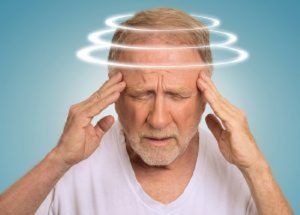
Meniere’s Disease can cause vertigo, which is a sensation of spinning that leads to nausea and potentially vomiting!
When we think of hearing loss, we often think of old age or loud noises. However, hearing loss can also occur from certain diseases. Meniere’s Disease affects the inner ear which is responsible for both our hearing and balance. The cause is unknown, but it is believed to be caused by changes in the fluid in the tubes of the inner ear. Here is some more information on Meniere’s Disease.
Symptoms
The National Institute on Deafness and Other Communication Disorders says that about 615,000 people in the US have Meniere’s Disease and about 45,000 are diagnosed each year. This disorder is most likely to occur in adults that are in their 40’s and 50’s. Symptoms of Meniere’s Disease include:
- Vertigo: A sensation of spinning that can cause nausea, sweat, and vomiting
- Hearing Loss
- Tinnitus: A ringing sensation in the ear
- Loss of Balance
- Headaches
- Aural fullness: A feeling of having a clogged ear.
People with Meniere’s Disease will often experience multiple symptoms at one time.
How is it Diagnosed?
There are two common methods of diagnosing Meniere’s Disease: Hearing tests and balance tests. The hearing test first determines if the patient has hearing loss and whether it’s in one or both ears. After this, an electrocochleography test is done which measures electrical activity in the inner ear, determining if the problem is inside of the inner ear.
Doctor’s Typically use an electronystagmography balance test to test for Meniere’s Disease. With this, they will place electrodes around your eyes to observe your eye movements. They will also push water through your ears to activate your balance function. Any involuntary eye movements that occur during these times can indicate problems with the inner ear.
Treatment
While there is no cure for Meniere’s Disease, there are treatment options available to help with the symptoms. These include:
- Medication: There are a variety of medications that will help with vertigo, vomiting, and nausea. Other medications try to reduce the amount of fluid in your body to help with symptoms.
- Physical Therapy: Doctors can use Vestibular Rehabilitation to help with the symptoms of vertigo. These exercises help to train your brain to make up for the difference in the balance between the ears.
- Hearing Aids: A hearing aid can help to treat the hearing loss that comes with the disease.
- Surgery: This is a less common treatment option and typically only used for those who have severe episodes and no success with other treatments. The procedure done helps to decrease fluid production in the body and help the inner ear drain fluids.
Contact Bay Area Audiology Today!
If you are concerned about hearing loss or seeking hearing evaluations, tinnitus evaluations, or hearing aid assistance, our doctors are ready to help. We are passionate about helping all of our patients improve their quality of life through better hearing. We also believe that patient education is critical, so you won’t be lead through endless sales pitches at our office. If you are interested in hearing how we can help you hear even better, contact us at (410) 838-4327 or online. For more hearing tips and articles, follow Bay Area Audiology on Facebook, Twitter, Google+, Pinterest, and LinkedIn.
